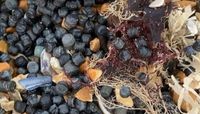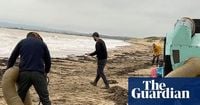On November 6, 2025, the normally tranquil shores of Camber Sands in East Sussex were transformed into the site of a major environmental crisis. Millions of tiny plastic pellets—known as biobeads—washed up along the coastline, creating what experts and local officials are now calling an "environmental catastrophe." The incident has mobilized local authorities, environmental groups, and volunteers in a race against time to mitigate the damage and uncover the source of the pollution.
The biobeads, small dark grey or black plastic particles about 5mm in size, are commonly used in water treatment plants to help clean sewage. According to the BBC, Rother District Council was first alerted to the pollution when large quantities of these pellets began appearing on the Camber coastline. The council quickly launched an inspection of the shorelines to assess the scale of the incident, which soon revealed that the pollution stretched for nearly two miles, embedded in dense seaweed and sand.
"It's unclear where the pollution has come from and investigations are ongoing," a council spokesperson told BBC. The council also advised dog owners to supervise their pets to prevent them from ingesting the pellets, which are known to contain harmful substances, including carcinogenic polycyclic aromatic hydrocarbons and toxins like lead, antimony, and bromine. While there have been no reported public health concerns so far, the potential risks to both pets and local wildlife are significant.
Southern Water, the regional water utility, has been drawn into the spotlight as the likely source of the spill. Helena Dollimore, the Member of Parliament for Hastings and Rye, wrote a letter to Southern Water’s chief executive demanding a full explanation. She pointed out that there had been no reports of ships in the English Channel spilling such beads, suggesting the pollution likely originated from local wastewater treatment plants. "Southern Water must urgently establish if their local wastewater plants could be the source of these biobeads, and I’ve asked them to dedicate all available resources to supporting the clean-up operation in the meantime," Dollimore stated, according to The Guardian.
Southern Water has maintained that the investigation is ongoing. In a statement shared with Sky News and other outlets, a spokesperson said, "We are working closely with the Environment Agency and Rother District Council to investigate the source of plastic beads which have washed up on Camber Beach. This investigation work is ongoing." The company also noted that water quality sampling on the beach showed no impact to environmental water quality, and this data has been shared with both the council and the Environment Agency.
Despite these assurances, the environmental consequences are already being felt. Camber Sands is not just any beach; it is home to rare sand dunes protected as a Site of Special Scientific Interest (SSSI) and recognized as a Site of Nature Conservation Importance (SNCI). The fragile strandline and dune habitats are particularly vulnerable to this kind of pollution. Andy Dinsdale of the not-for-profit group Strandliners, which monitors pollution along the south coast, did not mince words: "This is catastrophic for the fragile strandline and dune habitats at Camber," he told BBC. Dinsdale later described the event as "the worst pollution event I have ever seen. It is contaminated plastic. Marine animals will ingest small plastic items once they are in the sea, they will attract algae, they will smell like food, effectively. Once they’ve eaten it, that’s it: they can’t get it out. They will float on the surface. It will create a slick which attracts plunging seabirds."
The clean-up operation has been massive, yet daunting. Volunteers, including local residents like Juliet Duff, have been collecting the pellets by hand and with dustpans and brushes. "The pollution covers about a mile and a half of the beach," Duff shared with BBC. "We have been collecting the pellets up by hand and with dustpan and brush." Yet, the scale of the spill makes complete removal seem nearly impossible. Dinsdale noted, "They are so small that, from a very long way off, the beach looks normal. But as soon as you get close up you see there are millions of black pellets, nestled under seaweed. It’s an impossible task – volunteers have been raking for days, and they will continue to rake, but we won’t be able to get rid of them all."
Specialist contractors, equipped with suction vehicles, have been brought in by Rother District Council to aid the clean-up, and both the non-profit organizations Nurdle and Strandliners are working alongside council officers. The Environment Agency has been providing advice and guidance while also working to identify the pollution’s origin. "We are providing advice and guidance to Rother District Council, which has employed contractors to carry out a clean-up operation. This work is currently under way. We are working with other responders to identify the source of the pollution," an Environment Agency spokesperson told The Guardian.
As the investigation continues, there is mounting pressure on Southern Water to clarify how the biobeads entered the marine environment. MP Helen Dollimore has been vocal about the need for answers and accountability, stating she will continue pressing the company for a full explanation. Local environmental groups and volunteers are also calling on residents to check neighboring beaches for signs of biobeads and to report their findings, hoping to track the full extent of the spread.
The environmental impact is already visible. According to Dollimore, "These biobeads are deadly to marine life and wildlife, and we are already seeing more dead seals, fish and porpoises on the beach." The threat extends beyond marine creatures to dogs and potentially humans, given the toxic substances contained in the beads. The full ecological cost may not be known for some time, but the urgency of the response reflects the seriousness of the situation.
Camber Sands, with its golden dunes and protected habitats, now faces a long road to recovery. The incident has highlighted the vulnerabilities of coastal environments to industrial pollution and the importance of stringent safeguards in waste management. As investigations proceed and clean-up efforts continue, the community’s resolve and the cooperation between agencies, volunteers, and local authorities will be crucial in restoring one of England’s most cherished beaches to its former state.

